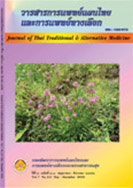The Integration of Thai Traditional Medicine into Public Health Systems: The Role of Buddhist Monasteries as Health Care Providers for Communities
Main Article Content
Abstract
This study explores the state of the services in Thai Traditional Medicine (TTM) undertaken by Thai wats and the role they play in providing people with health care in order to draw conclusions about their
success as well as relevant contributing factors and make suggestions on how to support them. This will help further develop their services in accordance with the communities’ cultural context and integrate Thai Traditional
Medicine into the country’s public health systems. Nine monasteries in four regions were selected for this qualitative study based on information collected from focus groups and indepth interviews of their abbots,
responsible persons and TTM practitioners during the period from May 2007 to March 2008.
The study found that the services provided by the wats consider health from a holistic point of view including
physical, mental and social perspectives. Thai Traditional Medicine is also based on trust, and good relationships between TTM practitioners, patients and their relatives. Practitioners at these wats are mainly
monks and folk doctors. The services are typically run by the monasteries’ managing committees (kammakarnwat), with the abbots or the monk healers being top decision-makers. People experiencing muscle stiffness or
pain, and those who are partially or fully paralyzed form the majority of the patients. They are usually treated using two methods: herbal medicine prepared by the practitioners themselves and traditional massage.
Some wats have a documentation system to keep the patients’ records or arrange for their referrals to hospitals.
Three models are suggested in order to support and integrate the temples’ TTM services into the Thai public health system. Model 1: Monasteries are the center of people’s health care as well as a unique one; they currently maintain health within the community. Model 2 : Monastries in some areas are not the center of the health care system within the community but act as a gathering point for people with health problems within the community. Model 3: The integration of the community health system and the Thai public health care system should be done by the monastries forming the center, thereby empowering a networking system.
Article Details
References
2. ลือชัย ศรีเงินยวง, วิชิต เปานิล. ทางเลือกในการดูแลและรักษาสุขภาพของประชาชนสังคมไทย: ความแพร่หลายการใช้และเหตุผล.นนทบุรี : สถาบันวิจัยระบบสาธารณสุข;๒๕๔๕.
3. โกมาตร จึงเสถียรทรัพย์. สุขภาพไทย วัฒนธรรมไทย. กรุงเทพฯ: สำนักวิจัยสังคมและสุขภาพ;๒๕๕๐.
4. Frake CO. The diagnosis of disease among the Subanana of Mindanao. American Anthropologist 1961;63:113-32.
5. เสาวนีย์ กุลสมบูรณ์, รุจินาถ อรรถสิษฐ. สถานภาพและทิศทางการวิจัยภูมิปัญญาพื้นบ้านด้านสุขภาพ. กรุงเทพฯ : โรงพิมพ์องค์การสงเคราะห์ทหารผ่านศึก;๒๕๕๐.
6. ทิวา ธรรมอำนวยโชค. พุทธศาสนาและการรักษาพยาบาล: วิเคราะห์บทบาทพระสงฆ์ในการรักษาพยาบาลชาวบ้านในเขตกรุงเทพมหานครและจังหวัดใกล้เคียง. วิทยานิพนธ์อักษรศาสตรมหาบัณฑิต, สาขาวิชาศาสนาเปรียบเทียบ บัณฑิตวิทยาลัยมหาวิทยาลัยมหิดล; ๒๕๓๐.
7.กุสุมา ศรียากูล, นวลจันทร์ ใจอารีย์, สุภาพร ประทุมวงษ์. การใช้ภูมิปัญญาไทยในการดูแลสุขภาพชุมชนของวัดในเขตภาคกลาง.ปทุมธานี:คณะแพทยศาสตร์ มหาวิทยาลัยธรรมศาสตร์;๒๕๓๕.
8. ยศ สันติสมบัติ. ความหลากหลายทางสังคมและภูมิปัญญาท้องถิ่นเพื่อการพัฒนาที่ยั่งยืน.เชียงใหม่:นนทบุรีการพิมพ์;๒๕๔๒.
9. Durrenberger EP. The ethnography of Lisu curing. Unpublished Ph.D. thesis, University of Illionois at Urban-Champaign; 1971.


